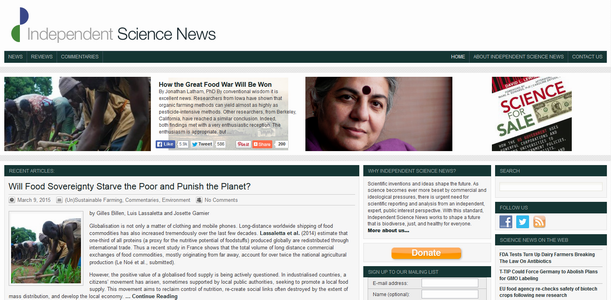|
|

Independent Science News
Connexions Directory of Groups & Websites 2025
c/o The Bioscience Resource Project
PO Box 6869
Ithica NY 14850,
E-Mail: info@independentsciencenews.org
Website: http://www.independentsciencenews.org/
Purpose: Scientific inventions and ideas shape the future. As science becomes ever more beset by commercial and ideological pressures, there is urgent need for scientific reporting and analysis from an independent, expert, public interest perspective. With this standard, Independent Science News works to shape a future that is biodiverse, just, and healthy for everyone.
Scientific facts are not always what they seem. Whether it#s counting the future world population, quantifying the deaths following Chernobyl, or determining the safety or the effectiveness of commercial products (from pharmaceuticals to basic foodstuffs), powerful interests routinely succeed in influencing the answers. In science, external forces influence strongly what is studied, what is published, and what is reported. When that happens, individuals (or policymakers) no longer have the information to decide rationally and choose thoughtfully. Society becomes dysfunctional at a fundamental level.
Manipulation of science can be surprisingly easy. That is because, at every level within it, important decisions are typically not transparent (even to other scientists). Manipulation is also aided by science#s protective mythology of impartiality and rigour that deters questioning by outsiders. Therefore, it often goes unnoticed.
But of even greater concern than the manipulation of facts is the suppression, manipulation, or invention, of scientific ideas.
Over the last 50-60 years, selected scientific ideas have been actively promoted out of all proportion to their evidence base. These specific ideas were ones deliberately chosen for their potential to channel popular thinking to fit various corporate agendas. Perhaps the most stunning example of this is how corporations and governments have conspired to create a genetic determinist understanding of society and of human nature, even though the evidence to support that view is missing. They have sought to manufacture a public consensus that genes (and not junk food, pesticides or poor public policies) are chiefly to blame for ill heath, inequality and social dysfunction. Thus from the 1950s onwards the tobacco industry (at first alone) massively funded human genetic research in an attempt to shift blame for tobacco-related illnesses onto purported genetic predispositions (i.e. individuals). Thus a strategy rooted in an unsupported scientific idea nevertheless repeatedly shifted legal opinion and public policy attention away from the activities of the companies and their products. Without its secret manipulation of genetic research it is likely the tobacco industry would not exist today.
In a separate example, the efficacy of animal experimentation has for many years been grossly exaggerated by chemical corporations who need a scientific reassurance to offer to a population that is exposed to and contaminated by their products. Note a key point: that in both cases this type of intellectual manipulation is hard to detect because the specific ideas (genes cause disease; animal experiments work) appear politically neutral. They are not overtly associated with any product or organization. The ultimate intent of such deceptive ideas (more examples below), which originate often with PR companies, is to constrain public thought and shift mass opinion into narrow bounds amenable to those powerful interests. The ultimate goal is to permit (for example) politicians to #rationally# declare that there is no alternative to a chosen policy when in fact the arguments in favour are based on a hidden ideology. This manipulation of information is all necessary because, as Abraham Lincoln said, 'With public opinion nothing can fail; without it nothing can succeed'.
Examples of science journalists exposing deceit and manipulation are rare. They are rare mostly (though not entirely) because science reporters, even at Science magazine and the New York Times, see themselves less as investigative journalists and more as explainers of science. Such journalists typically lack the independence, the public interest focus, and often the expertise, to contextualise scientific results and penetrate the inner logic of institutional agendas that are now necessary to explain much of science.
In no field of human endeavour is this more true or more important than in the subjects covered by Independent Science News (ISN): health, food and agriculture.
Therefore, the two aims of ISN are to call attention to defects in science and in the science media and to remedy them as far as possible.
ISN chooses its stories carefully. Most concern simultaneous manipulations of the scientific process, the food/ag system, and the science media, that span decades. These stories are deep: they have evolved slowly, have often cost their perpetrators hundreds of millions (sometimes hundreds of billions) of dollars to organize, and required extensive research to uncover and understand. Consequently, we encourage readers to look at older stories from ISN. If it is true that in order to remedy a system it is necessary to understand that system then readers will find these stories every bit as interesting and original as the newer ones. The remarkable facts and conclusions have in every case stood the test of time. All stories are ongoing. Just possibly you have new information on them. If so, please contact us.
Structure: Non-Profit
Subject Headings:Experts on similar topics in the Sources Directory:

|
Connect with Connexions



Newsletter Facebook Twitter

|





